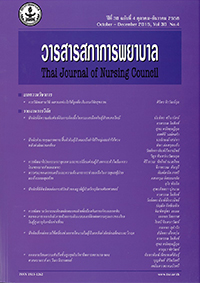การพัฒนานวัตกรรมเตียงพลิกตะแคงตัวเพื่อป้องกันการเกิดแผลกดทับ
Keywords:
นวัตกรรม, เตียงพลิกตะแคงตัว, แผลกดทับ, innovation, repositioning bed, pressure ulcerAbstract
บทคัดย่อ: วัตถุประสงค์ของการวิจัย: เพื่อสร้างและศึกษาประสิทธิผลของนวัตกรรมเตียง พลิกตะแคงตัวโดยใช้มือหมุนพร้อมเบาะนอน เพื่อช่วยส่งเสริมการจัดท่าและการพลิก ตะแคงตัวให้ถูกต้อง ช่วยลดและกระจายแรงกด กระตุ้นการไหลเวียนเลือด ทำให้เนื้อเยื่อ ได้รับอาหารและออกซิเจน ช่วยป้องกันและลดการเกิดแรงกดทับบริเวณปุ่มกระดูกของร่างกาย
การออกแบบวิจัย: การวิจัยเชิงพัฒนานวัตกรรม
การดำเนินการวิจัย: กลุ่มตัวอย่างที่เป็นผู้ป่วยที่มีความเสี่ยงที่จะเกิดแผลเมื่ออยู่ที่ บ้านจำนวน 13 ราย ระหว่างเดือนมกราคม– มิถุนายน 2558 ใช้เตียงพลิกตะแคงตัวโดย ใช้มือหมุนพร้อมเบาะนอนที่พัฒนาขึ้น ซึ่งเตียงนี้สามารถไขปรับระดับศีรษะสูง 0 – 60 องศา ปรับระดับข้อพับเข่า 0 – 45 องศา และปรับระดับพลิกตะแคงตัวซ้ายขวา 0 – 30 องศา เครื่องมือ ที่ใช้ในการเก็บรวบรวมข้อมูล คือ 1) แบบประเมินการเกิดแผลกดทับ และแบบประเมิน ความพึงพอใจของญาติผู้ดูแล ในเขตจังหวัดพระนครศรีอยุธยาและปทุมธานี ในระยะเวลา 2 สัปดาห์ วิเคราะห์ข้อมูลด้วยสถิติพรรณนาและสถิติไคร์สแควร์
ผลการศึกษา พบว่าเตียงพลิกตะแคงตัวโดยใช้มือหมุนที่สร้างขึ้นนี้ มีความปลอดภัย และช่วยป้องกันการเกิดแผลกดทับได้อย่างมีนัยสำคัญทางสถิติ และญาติผู้ดูแลมีความพึงพอใจ ต่อการใช้เตียงพลิกตะแคงตัวอยู่ในระดับดีมาก
ข้อเสนอแนะ: เตียงพลิกตะแคงตัวโดยใช้มือหมุนพร้อมเบาะนอนที่พัฒนาจากพื้นฐาน ฟิสิกส์ทางการพยาบาลในเรื่อง
การจัดท่าและการพลิกตะแคงตัวที่ถูกต้องตามมาตรฐาน การพยาบาล ที่เป็นนวัตกรรมทางการพยาบาลที่จะช่วยแก้ไข
ปัญหาสุขภาพของประชาชน โดยการป้องกันการเกิดแผลกดทับซึ่งถือเป็นปัญหาที่มีผลกระทบต่อภาวะสุขภาพผู้ป่วย
โดยเฉพาะผู้ป่วยสูงอายุและผู้ป่วยที่ไม่สามารถช่วยเหลือตนเองได้ที่มีจำนวนมากในปัจจุบัน
Abstract: Objective: To develop an innovative knob-operated (or handle-operated) cushioned repositioning bed that promotes patients’ proper postures and positions, and evaluate its efficacy in reducing and diffusing pressure, stimulating blood circulation, increasing tissues’ nutrient and oxygen intake, and preventing and reducing tubercular pressure ulcers.
Design: Innovative development research.
Implementation: This study was conducted from January to June 2015 on 13 patients with a risk of pressure ulcers whilst convalescing at home in Ayudhaya and Pathumthanee provinces. Each of the subjects was asked to stay lying on either side in a specially designed repositioning bed for 2 weeks. The bed could be tilted sideways from 0 to 30 degrees, whilst its head section could be tilted from 0 to 60 degrees, and its knee section from 0 to 45 degrees. The data collecting tools were (1) a pressure ulcer evaluation form and (2) a satisfaction evaluation form for family caregivers. The data were analysed using descriptive statistics and chi-square statistics.
Results: The specially designed knob-operated (or handle-operated) cushioned repositioning bed was safe to use and prevented pressure ulcers at a statistically significant degree of efficacy. The family caregivers also rated this repositioning bed as highly satisfactory.
Recommendations: This knob-operated (or handle-operated) cushioned repositioning bed was developed based on physics for nursing science and on nursing standards in order to effectively enable the patients to properly reposition themselves at proper angles and in proper positions. An invention that prevents pressure ulcers, this innovative bed could be used to reduce complications in the growing population of elderly patients incapable of repositioning themselves in bed.
Downloads
References
Baumgarten, M., Rich, S.E., Shardell, M.D., Hawkes, W.G., Margolis, D.J., Langenberg, P., et al. Care-related risk factors for hospital-acquired pressure ulcers in elderly adults with hip fracture, J Am Geriatr Soc 2012;60:277-83.
Igarashi, A., Yamamoto, M.N., Gushiken, Y., Takai, Y., Tanaka, M., Okamoto, Y. Prevalence and incidence of pressure ulcers in Japanese long-term-care hospitals, Gerontol Geriatr 2013;56:220-6.
Guy, H. Pressure ulcer risk assessment. Nurs Times 2012;108: 16–20.
Suttipong C, Sindhu S. Predicting factors of pressure ulcers in older Thai stroke patients living in urban communities. J Clin Nurs. 2012;21:372-9.
Moore, Z.H., Cowman, S. Risk assessment tools for the prevention of pressure ulcers. Cochrane Database Syst Rev 2010; Issue 3, Art No: CD006471. DOI: 10.1002/14651858.CD006471.pub2.
European Pressure Ulcer Advisory Panel/National Pressure Ulcer Advisory Panel. International Pressure Ulcer Guidelines for Prevention and Treatment. Washington DC: NPUAP.;2010
Mamom,J, Chansawat, P, Niemrit S. Baikrut P.(2013). Effect of Wound Care Skills Model to Promote Wound Healing in Patients with Pressure Ulcers. Thai Science and Technology Journal (TSTJ) 2013; 20:609-19.(in Thai)
Erdfelder E, Faul F, & Buchner A. G POWER: A general power analysis program. Beh. Res. Meth. Instr. Comp. 1996; 28: 1-11.
Victor U. Patient and staff nurse’s experiences of the 30 degree tilt reposition technique, for the prevention of pressure ulcers, in an elderly care unit. [MSc Thesis]. Dublin: Royal College of Surgeons in Ireland;2013
Young T. The 30 degree tilt position versus the 90 degree lateral and supine positions in reducing the incidence of non-blanching erythema in a hospital inpatient population: a randomized controlled tri¬al. J Tissue Viability 2014;14(3):88–96.
Mamom,J. The Nurses Role and Pressure Ulcers: Challenge in Prevention and Management Thai Science and Technology Journal (TSTJ) 2012;20:478-90. (in Thai)
Haruenkaew, S., Pinitnanthakorn, A., & Li, X. Force Pad Sensor. (Senior Project Report). (2016). Thammasat University, Sirindhorn International Institute of Technology(SIIT).







